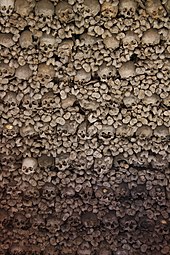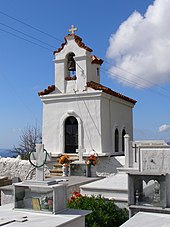Ossuary

The charnel house , even Ossarium or ossuary (from latin os , " bone ", plural: ossa ) is a covered space for storage of bones is determined. The termKarner , also Carnarium , Gerner , Kärnter , in some places also " Seelhaus " and called differently, refers to a chapel also used as an ossuary . In some places the complex has two levels, the upper one as a prayer room, the lower one as a leg cellar. In the canton of Schwyz in central Switzerland, the term Kerchel is used for a cemetery chapel that is both a burial room and an ossuary (like the Kerchel from Schwyz or that from Muotathal ).
Origin and building history

In Judaism , bone boxes made of stone are called ossuaries . After the body had rotted away, the remaining bones were cleaned and placed in ossuaries. At the time of the aboveground burial ban in the period up to around 1200, these were mostly placed in underground catacombs , but have not played a role in this religion since the beginning of burials.
There are various reasons for creating ossuaries. In part, these are collection points for the bones from cemeteries , where space had to be created for further burials , for which existing grave fields were re-occupied ( reburial of the bones) (example: Sant'Ariano in the lagoon of Venice ). An increase in the European population made the introduction of the ossuary necessary in the 11th and 12th centuries. It was not a change in the theological thinking of Christianity, but "this decisive step had become necessary solely because of practical requirements".
The ossuary is often associated with a cemetery chapel. The ossuary Karner or Gerner is specifically called in this form , this is the expression common in Austria and Bavaria. There are important ossuary from the 12th century in Hartberg and Mistelbach as well as one from the 13th century in Tulln or the Magdalenenkapelle Hall in Tirol .
In Lorraine , for example, there are ossuaries in a crypt beneath the church of Vintrange open to the cemetery and in Schorbach in Bitscher Land in a house with open, Romanesque-looking arcades in front of the west portal of the church.
Christian ossuaries are often dedicated to the Archangel Michael . They can have two storeys or were later extended. There is often a chapel in the upper room .
At the turn of the 20th century, ossuary became more and more out of use. Many were demolished or repurposed, some were used as memorials for those who died in the war, as morgues or storage sheds. In some of the monasteries in the city, the function of the ossuary has been preserved because of the limited space.
Ossuary can be found in cemeteries in many areas of Greece . There the bones are exhumed after a regionally different time (20 to 40 years) in a church rite and brought to the ossuary to make space for new burial sites.
Examples
Austria
The predominant name is Karner and sometimes ossuary .
- Lower Austria: Bad Deutsch-Altenburg , Burgschleinitz , Eggenburg , Friedersbach , Hainburg , Mistelbach , Mödling , Pottenstein (Doppelkarner), Pulkau , Tulln an der Donau , Wiener Neustadt , Zellerndorf , Zwettl
- Upper Austria: Enns , Hallstatt (with the largest collection of skulls in Europe), Mauthausen
- Carinthia: In Carinthia around 50 Karner are preserved, as in Ossiach , Friesach , Maria Saal , Metnitz , Moosburg , Rechberg , Villach , Deutsch-Griffen
- Salzburg: Hallein
- Styria: Karner Hartberg , Sankt Lambrecht
- Vorarlberg: Ludesch , Rankweil
- Tyrol: Elbigenalp in the Lechtal in the Martins and Magdalenenkapelle
Germany


The predominant name here except in Bavaria is ossuary .
- Baden-Württemberg: St. Georg in Gutach-Bleibach , St. Michael in Schwäbisch Hall (under the choir), St. Michael next to the parish church of St. Gallus in Ladenburg
- Bavaria (charnel houses and Karner as well as Carinthia): Aholfing , Allersburg, Altomünster , Arresting , Baldersheim (Aub) , Breitenbrunn , Beratzhausen , Chammünster , Dingolfing , Marzoll , Perschen , Rottendorf , Roding : Josephi Chapel with Anna Chapel , Sinzing , Großschönbrunn , Greding , Geltendorf- Walleshausen , Hemau , Landsberg am Lech , Neustadt an der Aisch , Pfaffenhofen near Kastl , Rain , Staubing near Weltenburg, Schorndorf , Reicholzried , Waischenfeld , Iphofen
- Hamburg: Under the altar of St. Joseph's Church
- Hessen: Ossuary next to the Lutheran parish church of St. Marien in Marburg , Michaeliskapelle in Wetzlar , St. Michael next to the parish church (Kapellenkarner) in Kiedrich , Michaelskirche in Fulda (crypt originally used as an ossuary), St. Michael (Limburg an der Lahn) , Basement of the Michaelskapelle at the collegiate church in Limburg-Dietkirchen, basement of the Michaelskapelle in Butzbach , ossuary (Alsfeld)
- Rhineland-Palatinate: Michaelskapelle in Alken on the Moselle (still filled), Michaelskapelle next to the Liebfrauenkirche in Koblenz (rebuilt), Michaelskapelle next to the Katharinenkirche in Oppenheim , Karden on the Mosel , ossuary in Deidesheim , under St. Peter and Paul in Westhofen
- As a variant, smaller Romanesque churches can be observed on the Middle Rhine, the sanctuary of which was raised to create a space below that was probably used as an ossuary. This form can be proven in the old church of St. Servatius in Koblenz-Güls , in St. Laurentius in Koblenz-Moselweiß (room removed in Baroque) and in St. Johannis in Niederlahnstein (room reconstructed).
- Mecklenburg-Western Pomerania: ossuary (Bad Doberan) , Doberan monastery (early Gothic ossuary)
- Lower Saxony: bone tower in Einbeck , ossuary chapel in the town hall in Goslar
- North Rhine-Westphalia: St. Ursula ("golden chamber")
Switzerland

The name is mainly ossuary .
- Graubünden: Church of St. Peter Mistail in Alvaschein, Falera , Poschiavo
- Central Switzerland and the Swiss Plateau: Baar ZG , Emmetten , Ettiswil , Hasle LU , Schlachtkapelle Sempach , Steinen (Canton Schwyz) , Wolhusen , Zug (city) , Sursee , Gränichen , Deitingen , Stans
- Northwestern Switzerland : St. Jakob an der Birs in Basel, ossuary at the fortified church St. Arbogast in Muttenz, Rümlingen , Frick
- Eastern Switzerland: Our Lady Chapel at the parish church of St. Johann in Rapperswil SG (two-story Gothic building with chapel), St. Peter and Paul on the island of Ufenau , Ritterhaus Bubikon , Bubikon ZH
- French-speaking Switzerland : Montreux
- Ticino: Coglio , Gordevio , Astano
- Valais: Bourg-Saint-Pierre : Morgue des Hospices on the Great St. Bernhard , Leuk , Naters
South-Tirol
In South Tyrol the terms Karner and Beinhaus , as well as the Italian-influenced Ossario, are used.
France
The French word for ossuary is ossuary .
- Alsace: Dambach-la-Ville Chapel of St. Sebastian with ossuary, Margaretenkapelle Epfig (simple construction from the 11th century. A karner on the north side forms the extension of the vestibule. In the oculus dated 1601)
- Île-de-France: ossuary of the parish church of Saint-Séverin , ossuary of the Père Lachaise cemetery, ossuary of the catacombs
- Lorraine: Douaumont ossuary near Verdun, Marville , Vintrange , Schorbach Romanesque ossuary from the mid-12th century
- Normandy: Rouen , Pestbeinhaus
Italy
In Italy the term ossario is common.
- Sant'Ariano island in the Venice lagoon
- Santa Maria Immacolata a Via Veneto in Rome
- Ossario Santa Maria della Neve near Melegnano
- San Candido
- Ossario di Solferino , commemorating the Battle of Solferino
Greece
Portugal
- Igreja Matriz in Alcantarilha
- Igreja de São Francisco in Évora
- Igreja do Carmo in Faro
Czech Republic
- Sedletz Ossuary in Kutná Hora
- Ossuary in Mělník
- Ossuary in Kolín
- Ossuary in Sankt Maurenzen
- Ossuary in Brno
Bulgaria
- Ossuary in Balgarowo
- Ossuary in Batak
- Ossuary in the Schipkad memorial
Individual evidence
- ^ Max Döllner : History of the development of the city of Neustadt an der Aisch until 1933. 1950; 2nd edition, Ph. CW Schmidt, Neustadt an der Aisch 1978, ISBN 3-87707-013-2 , pp. 88 and 559, note 2.
- ↑ rdklabor: ossuary .
- ↑ Reiner Sörries: The medieval cemetery. In: Norbert Fischer (ed.): Space for the dead. The history of the cemeteries from the burial roads of Roman times to anonymous burials. 2003, ISBN 3-87815-174-8 , p. 38.
- ↑ Entry on The Hallstatt Bone House in the Austria Forum (in the Heimatlexikon), accessed on January 4, 2011.
- ↑ Ilse Spielvogel-Bodo: The Ossiacher See between yesterday and today. History, art, regional studies. 2nd Edition. Kärntner Druck- und Verlagsgesellschaft, Klagenfurt 1998, ISBN 3-85391-149-8 , p. 51.
literature
- Wolfgang Westerhoff: Karner in Austria and South Tyrol. Lower Austrian Press House, St. Pölten / Vienna 1989, ISBN 3-85326-891-9 .
- Reiner Sörries: On the architectural history of the Karner in Carinthia. In: cemetery and memorial. Year 38, 2/1993 Arbeitsgemeinschaft Friedhof und Denkmal Kassel, pp. 25–37.
- Jörg Scheidt: The ossuary of Oppenheim. In: Oppenheimer Hefte. 40, Oppenheim 2011, pp. 17-41.
Web links
Individual Karner:




